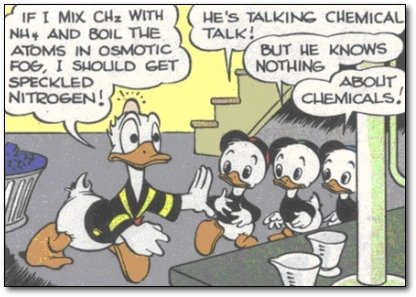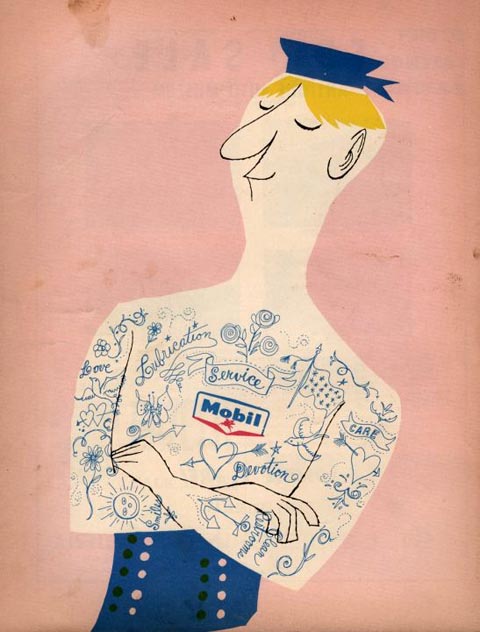Links and write-ups about beautiful things from around the web!
-
Pee Wee on the Gong Show
[Video no longer available]
More from the “things I did not know” file: Paul Rubens’s first widely-seen appearances, years before he hit it big as Pee-Wee Herman, were on the Gong Show.
-
Its the Dialogue of the Pieces
It’s the dialogue of the pieces, not the pieces themselves, that creates aesthetic success. From number 51 in 101 Things I Learned in Architecture School by Matthew Frederick. I heard this quote this past week as part of the “Music of Interaction Design” panel at SxSWi presented by Cennydd Bowles and James Box. Here’s a short PBS NewsHour writeup about the panel with a video interview of the two designers.
-
Donald Duck Discovered Methylene

Actually, he does. Donald Duck accidentally (and somewhat accurately) described the chemical compound methylene nearly two decades before real-world scientists:
In 1963, the Disney Studio learned just how wide and faithful a readership [Carl] Barks had. A letter arrived from Joseph B. Lambert of the California Institute of Technology, pointing out a curious reference in “The Spin States of Carbenes,” a technical article soon to be published by P.P. Gaspar and G.S. Hammond (in Carbene Chemistry, edited by Wolfgang Kirmse, New York: Academic Press, 1964). “Despite the recent extensive interest in methylene chemistry,” read the article’s last paragraph, “much additional study is required…. Among experiments which have not, to our knowledge, been carried out as yet is one of a most intriguing nature suggested in the literature of no less than 19 years ago (91).” Footnote 91, in turn, directed readers to issue 44 of Walt Disney’s Comics and Stories. … A year later, the Studio received a letter from Richard Greenwald, a scientist at Harvard. “Recent developments in chemistry have focused much attention to species of this sort,” Greenwald commented. “Without getting technical let me say that carbenes can be made but not isolated; i.e. they cannot be put into a jar and kept on a shell. They can, however, be made to react with other substances. Donald was using carbene in just such a manner, many years before ‘real chemists’ thought to do so.”
(Via Cracked’s 5 Amazing Things Invented by Donald Duck [Seriously])
-
Optical tweezers and laser tractor beams
Mind-boggling stuff like this is why I keep reading science journals. We can already use photons to push and pinch things with their tiny mass (amazing enough), but new research is underway in how to pull with photons:
Light is pushy. The physical pressure of photons is what allows for solar sail space missions that ride on sunlight, and what allows for dreams of lasers that will push those sails even faster. And light can trap objects, too: Optical tweezers can hold tiny objects in place. Pulling an object with light, however, is another matter. … Jun Chen’s research team says that the key is to use not a regular laser beam, but instead what’s called a Bessel beam. Viewed head-on, a Bessel beam looks like one intense point surrounded by concentric circles—what you might see when you toss a stone into a lake.
-
IBM 2250 Graphics Display

The IBM 2250 graphics display, introduced in 1964. 1024×1024 squares of vector-based line art beamed at you at 40Hz, with a handy light pen cursor. Much more handy than those older displays that just exposed a sheet of photographic film for later processing!
(Via Columbia University, via Ars Technica’s recent quick primer on computer display history)
-
Bell Labs Dial with Music DTMF

From a 1950 issue of Popular Science, an ad featuring Bell Lab’s early multi-frequency signaling keyboard for connecting long distance phone calls, in the era just before DTMF dialtones were introduced to America’s households.
(Via the always-interesting History of Phone Phreaking blog, which links to a couple of other good vintage Bell Labs ads)
-
Sanford & Sons and Jelly Belly
Back of the Cereal Box noticed the jarring disambiguation message on the Wikipedia entry for Jelly Belly, and wrote:
Why is it so much better that the name Jelly Belly can refer to either the brand of fancy jellybeans or the horrific disease pseudomyxoma peritonea, in which a tumor causes excess mucus production that swells the abdomen and compresses and endangers the various torso vital structures?
David Klein, the creator of the Jelly Belly (the candy, not the stomach cancer…), responded to the above post with the trivia that the bean’s name was inspired by the name of blues musician Lead Belly, which he’d heard on an episode of Sanford & Son. I’ll go one step further down the trivia chain: I assume he’s referring to the episode “The Blind Mellow Jelly Collection” (YouTube straight to the clip)!
This almost seems poetic: Klein named his candy business after watching a TV episode about a man unwittingly selling his valuable record collection, and later he himself met a similar fate, forced to sell his rights to Jelly Belly early on, for a significantly low value.
-
Ward Kimball Mobil Ads

Legendary Disney animator Ward Kimball also drew on the side for antique-auto-enthusiast magazine the Horseless Carriage Gazette (and he contributed a lot over nearly 30 years: his name comes up frequently if you search for him in this index of the magazine). He also worked on custom ads for Mobil that ran in the Gazette, like the nice tattooed guy above, or this fun one with the Mobil Pegasus.
According to an interview cited by Cartoon Brew, an angry Walt Disney made Kimball stop contributing to the magazine, even though it was on his own time and for gratis. Thankfully these scans are cropping up on the Ward Kimball Facebook page, along with lots of other great stuff!
-
Attentrons
I need to bring this theory up the next time I’m asked to create another link farm or overly-featured application. Neil Hunt, Chief Product Officer of Netflix, responds to a question on Quora about A/B testing and usability (in the comments):
“Simple trumps complete” – a 5% feature (used by less than 5% of all users) is a distraction for all the other users, and is better removed, unless its really critical (a small number of users do need to cancel service, for example).
I have this mental model of particles of attention that a user brings, a finite quantity that they will spread around according to what catches their attention. I call them “attentrons”. An extra tab or button will attract a bunch of attentrons that are not then available to focus on other areas. So the tab had better be *better* than the competing areas of the site to avoid diluting the results, or it’s better off removed.
(Via Jared Spool’s excellent User Interface Engineering blog)
